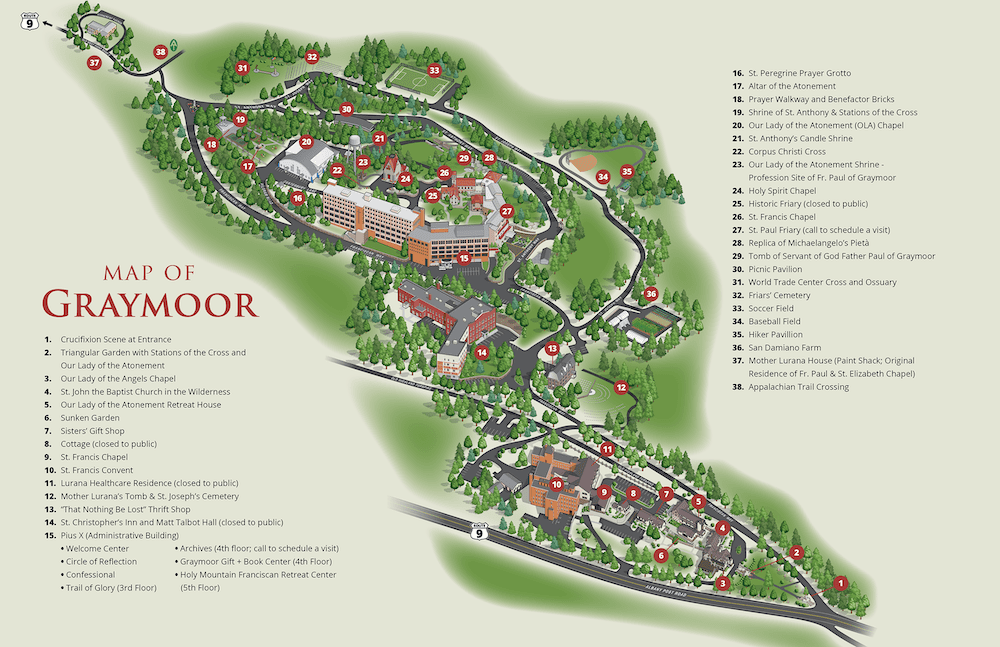
His Eminence Timothy Cardinal Dolan names Graymoor a Designated Jubilee Pilgrimage Site.
Welcome to Graymoor! Nestled in the Hudson Valley, our vast and expansive grounds have offered spiritual refuge and healing for more than 125 years. We invite you to click on each location below to read and listen about our rich history and enjoy stories behind various chapels, shrines, statues, and buildings. Whether you’re here for prayer, reflection, or exploration, may this journey through Graymoor deepen your sense of connection — to God, others, and the world.
Audio Tour of Sites at Graymoor
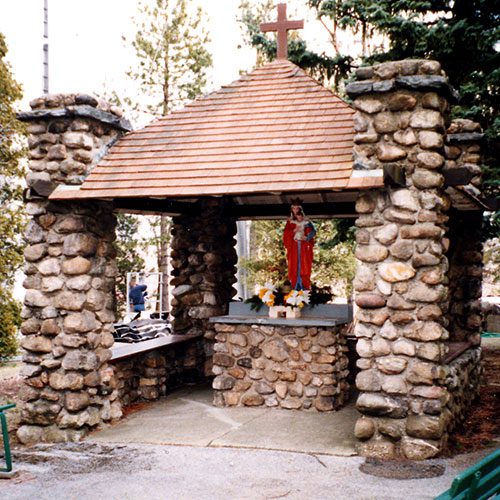
Next to the Corpus Christi Cross stands a Shrine to Our Lady of the Atonement. She rests on a small altar under a wood shingle roof supported by four husky pillars made of round stones. On this spot, Father Paul, then Reverend Lewis T. Wattson, took the vows of poverty, chastity, and obedience. It was Friday, July 27, 1900. It was a monumental day for the Society of the Atonement.
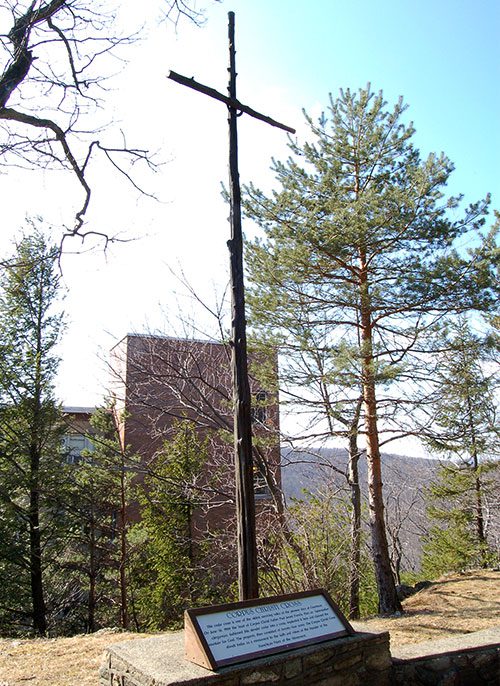
A few feet to the left of Holy Spirit Chapel stands the statue of an angel. It’s just a few steps away from the Corpus Christi Cross. It was high noon on June 14, the Feast of Corpus Christi, 1900 when four men gathered at the foot of the Graymoor Mountain. Father Paul, with the help of Ferdinand Wallerstein, a Jewish convert to the Anglican Church who later became Brother Anthony and a homeless man cut down a cedar tree, stripped it of its branches, and formed it into a cross. Father Paul then placed it on his shoulders, and the three proceeded up the mountain, accompanied by the fourth man, the Reverend John Howell Geare, who read out loud from the Book of Common Prayer. When they reached the summit, they erected the cross. By raising the cross, Father Paul claimed the mountain for God. It was now the Mount of the Atonement. In time, the crossbar of the Corpus Christi Cross rotted and was replaced. The upright shaft remains remarkably firm without a preservative coat. A sign at the foot of the cross reads, “The Corpus Christi Cross stands today as a monument to the faith and vision of the founder of the Franciscan Friars of the Atonement.”
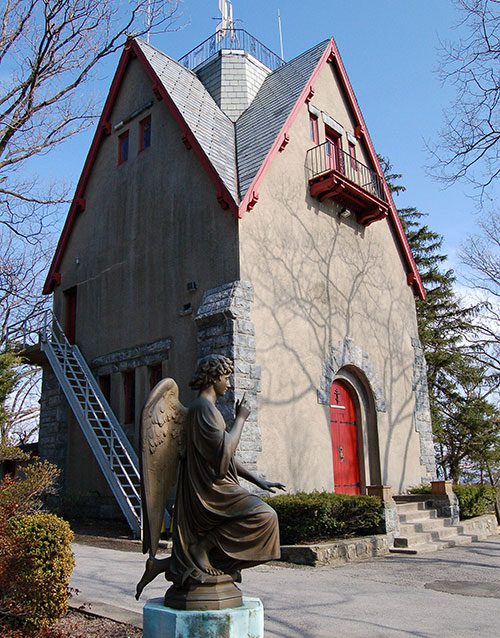
Standing tall on Graymoor’s 700-foot summit is Holy Spirit Chapel. In the summer of 1919, the cornerstone was laid for a two-story water tower, and the bottom of that water tower contained a chapel dedicated to the Holy Spirit, called, at the time, Holy Ghost Tower. The water tower itself was constructed by Graymoor’s favorite mason, Joe Schmidt of Bavaria. A homeless man from St. Christopher’s Inn, Schmidt built many of Graymoor’s shrines and walls. Three magnificent stained glass windows celebrate Pentecost. Icons of St. Nicholas, the wonder worker, decorate the rear of the chapel. The front door of the chapel is marked with a three-bar cross of the Eastern Rite. After Vatican II the name of the chapel was changed from Holy Ghost Chapel to Holy Spirit Chapel. Although sometimes referred to as Graymoor’s Byzantine chapel, Holy Spirit Chapel retains all of its Roman Rite symbolic art and stained glass windows. Hence it’s neither totally Eastern nor Roman.
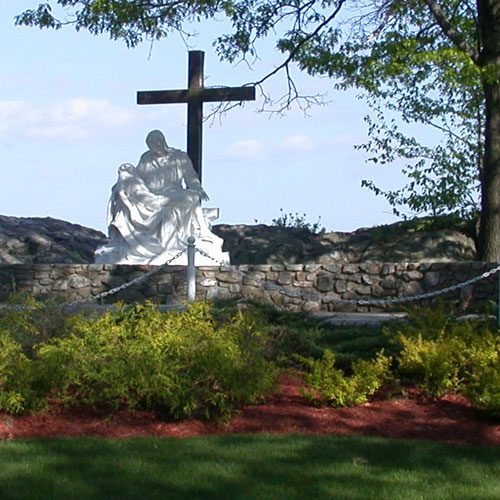
The path outside St. Francis Chapel leads us to the tomb of Father Paul. Father Paul was born Lewis Thomas Wattson on January 16, 1863. He was born to an Episcopal priest, Joseph Newton Wattson, and his wife, Mary Electa. As a boy of 10, Lewis heard an interior voice tell him he would found a preaching order like the Paulists. Wattson was ordained a priest in the Episcopal Church and worked in St. John’s Church in Kingston, New York, and its mission church, Holy Cross. It was at St. John’s that Father Paul discovered the name of the order he would found, the Society of the Atonement. In October of 1909, he, Mother Lurana, and 15 other people associated with the Society of the Atonement came into the Roman Catholic Church. Among the enterprises Father Paul began were the Church Unity Octave, a prayer movement for Christian unity, the Union That Nothing Be Lost, a self-denial organization to help the missions, and St. Christopher’s Inn for homeless men. Father Paul died at Graymoor in the room he lived in for 40 years on February 8, 1940. Looking down on the tomb is a replica of Michelangelo’s Pieta.
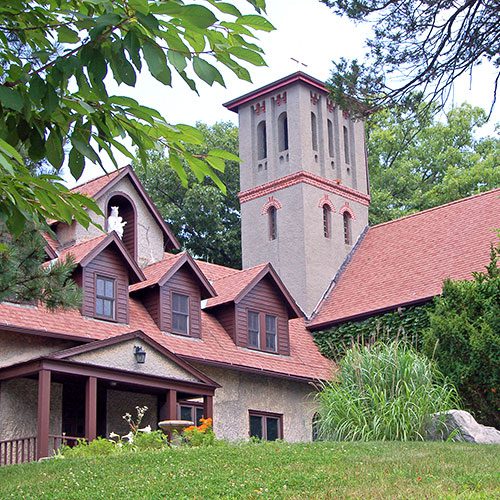
When the original St. Francis Chapel within St. Paul’s Friary became too small for the increasing number of friars, Fr. Paul decided to build another chapel, but he had only $200. He asked God for help, and within 36 hours, three homeless men who happened to be carpenters, arrived at St Christopher’s Inn. In gratitude, Fr. Paul called this chapel a monument to the skill and industry of the Brothers Christopher.
Inside this chapel, you find Graymoor’s museum piece. This altar once marked the spot on Mount Alverna where St. Francis received the holy stigmata. Above the altar stands a beloved statue of St. Francis, modeled on one by Andrea della Robbia. The original stands in the Transitus Chapel within the Basilica of St. Mary of the Angels in Assisi.
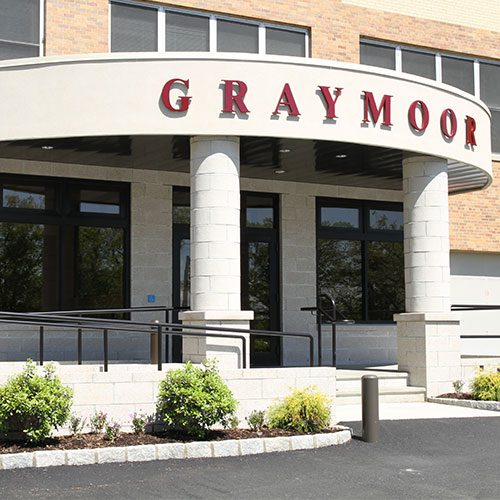
The St. Pius X Building is eight stories high with 281 windows. The reason this enormous building is dedicated to St. Pius X goes back to the summer of 1909, when the Friars and Sisters of the Atonement, then Episcopalian, petitioned the Pope to let them enter the Catholic Church as a religious congregation. St. Pius X’s answer was short but most welcome, “Yes, we will let them in.”
When you enter the building, you’re greeted by a wall of multicolored windows. Francis Cardinal Spellman, Archbishop of New York, dedicated the building September 8, 1960 as St Pius X Seminary. The seminary functioned for six years.
Today, this building houses the Friar’s administration offices and the Holy Mountain Franciscan Retreat Center.
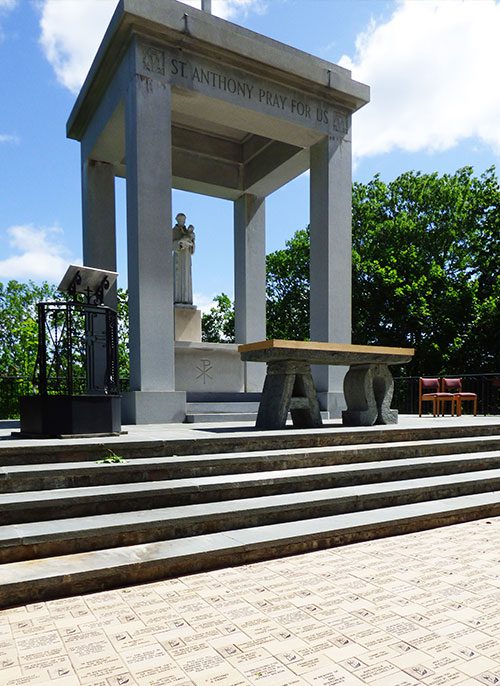
It was erected in 1960. The St. Anthony Shrine is a destination to thousands of pilgrims who flock to Graymoor for his June feast days. This is the culmination of Father Paul’s dream to have a magnificent shrine dedicated to the Franciscan saint of miracles. The Alpha and Omega altar was constructed of granite found here on the Holy Mountain by the men of St. Christopher’s Inn and installed there in 1932. It was relocated when the granite and fieldstone shrine was renovated and rededicated on its 50th anniversary. In 2016 the St. Anthony Prayer Walkway was added.
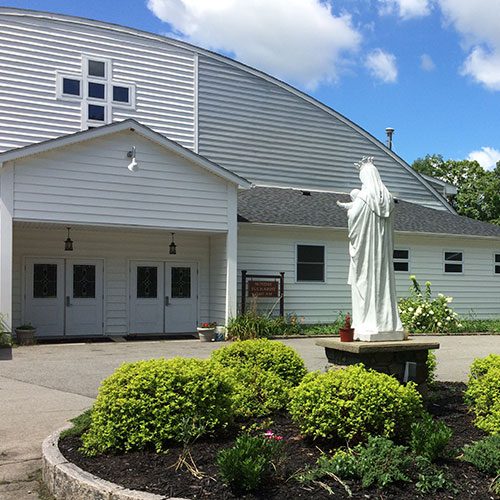
Our Lady of Atonement Chapel, once called Pilgrim Hall, is the largest meeting place at Graymoor. It’s just a two-minute walk down the hill from the north end of St Pius X building. Our Lady of Atonement Chapel resembles a large, white airplane hangar supported by 10 mighty buttresses. Dedicated on October 4, 1950, the chapel was built as a temporary facility to hold religious services for the many pilgrims that were coming to Graymoor at that time. A more elegant structure was planned for a later date, but that plan never materialized, and Pilgrim Hall, or Our Lady of Atonement Chapel, has been serving large crowd functions for over 75 years.
Originally called Pilgrimage Chapel of Our Lady of the Atonement, the title was changed to Pilgrim Hall in the 1960s so the facility could also be used for non-religious functions. Although not very churchly looking externally, the hall’s interior has an air of loftiness. Four sweeping arches made of Douglas Fir from Washington State span the entire ceiling and anchor themselves into the side walls. Behind the altar is a colossal icon of Christ seated on a throne. Visitors have remarked that it’s difficult to look away from the icon since it speaks through its gentle eyes.
Currently, Mass is held every Sunday at 11 AM at Our Lady of Atonement Chapel.
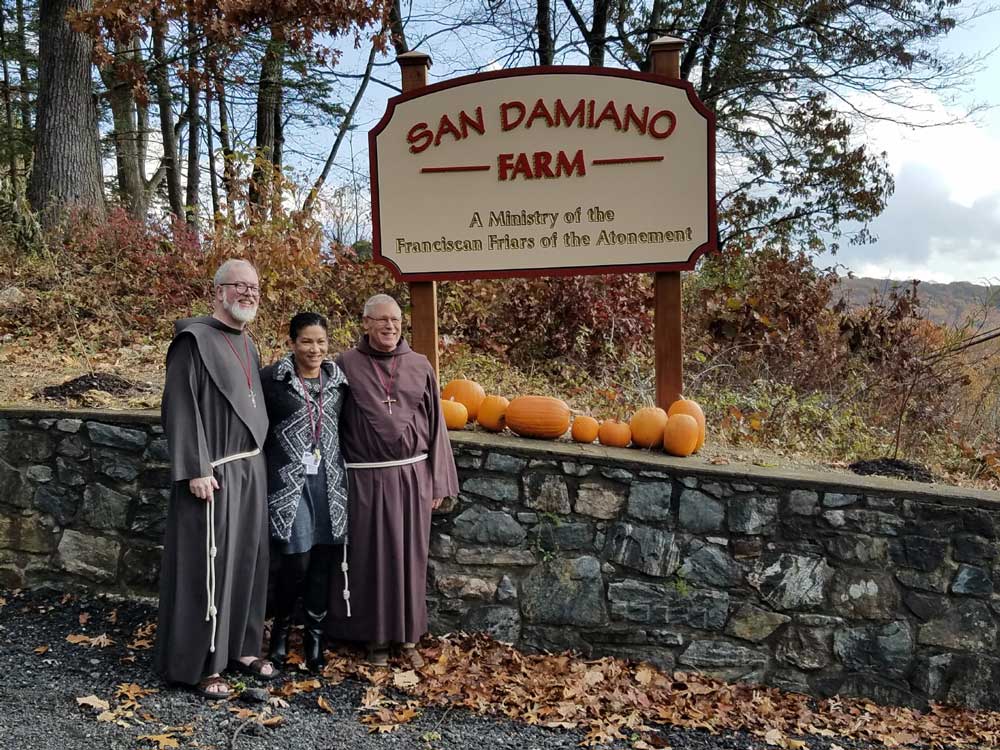
Named after San Damiano Church near Assisi, Italy, where St. Francis received his calling in 1205, the origins of San Damiano Farm trace back to 1916, the year Father Paul Watson founded St. Anthony Farm on this site. Men from the Inn worked the land from its inception. During World War II, this land produced grain to support the war effort.
From 1970 to 1985, the farmhouse served as the original home of New Hope Manor, a groundbreaking substance abuse treatment program for women founded here at Graymoor under the direction of Father Dan Egan, affectionately known as the Junkie Priest. Today, San Damiano House and Farm continues to fulfill its mission of hope. Men who have completed a component of treatment at St. Christopher’s Inn are offered housing and vocational training here as they work towards long-term recovery.
Some of the men volunteered to work at a farmer’s market on Fridays during harvest season.
Other Sites at Graymoor
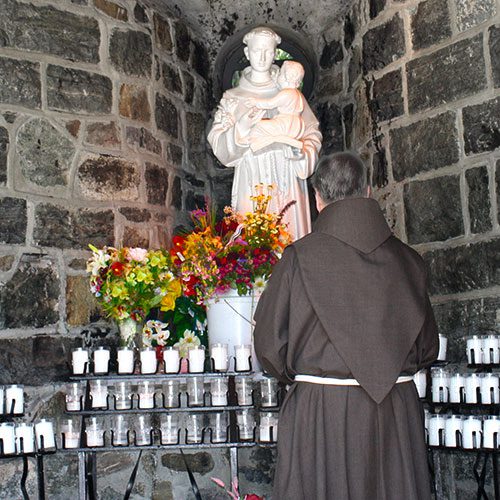
Pilgrims to Graymoor always stop to pray and light a candle at the St. Anthony Candle Grotto, as an act of devotion and faith in the miracle worker, St. Anthony’s intercession.
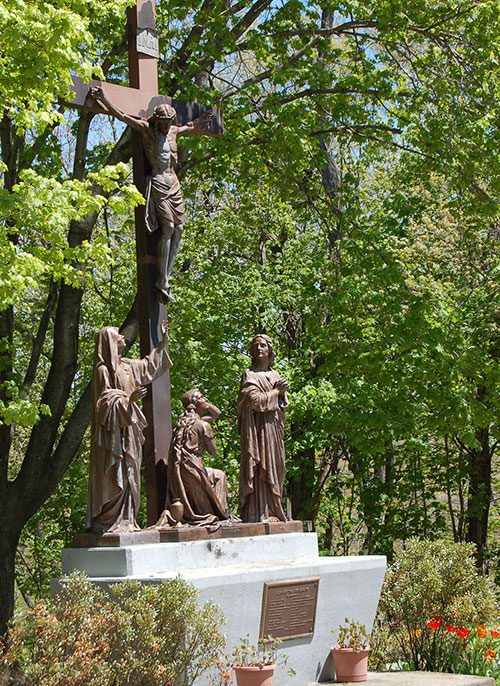
This bronze 16 foot high Crucifixion scene is at the entrance of the outdoor shrine to St. Anthony. The Stations of the Cross flank the side paths that lead to the large St. Anthony statue.
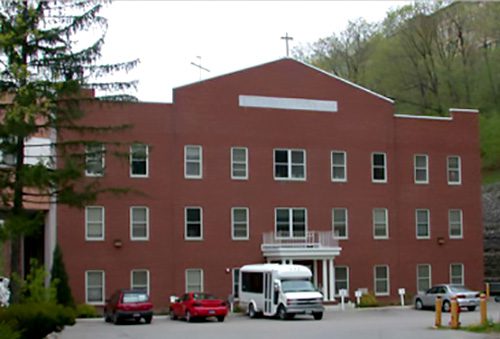
Father Paul and Mother Lurana saw the image of Christ in the homeless men who came to Graymoor. They called them “Brothers Christopher.” The first Inn began sheltering men in 1909. Since then, the Inn has been rebuilt 4 times. Today St. Christopher’s Inn provides a continuum of care for chemical dependency for up to 1000 men annually. They offer an integrated model of care including substance abuse services, healthcare, psychiatric care and shelter. Visitors are not permitted at St. Christopher’s Inn to protect client privacy.
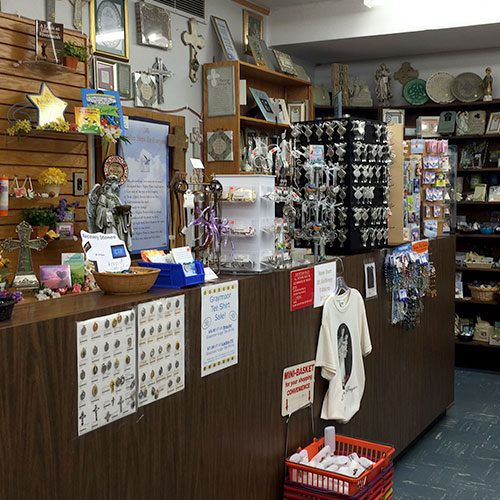
The friendly staff at the Graymoor Book and Gift Center can help you find devotional items, books, recovery items, workbooks, children’s, wedding and anniversary gifts, that will help you plant the seeds of faith. We offer thousands of items in stock including medals, cards, rosaries, statues, and all store proceeds support the Friars’ ministries.
Store Hours:
Wednesday – Saturday: 9-5
Sunday: 9-3
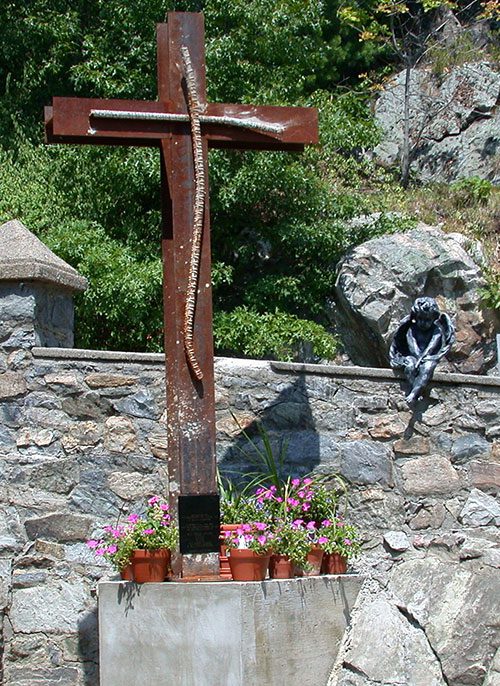
The World Trade Center Cross at Graymoor was erected by the Ironworkers of Local 40, NYC who constructed it of steel girders and ash from the WTC site, the Cross is a simple but powerful tribute to those who lost their lives on September 11, 2001. The memorial Cross was moved to a permanent location in 2016, north of the Friars’ cemetery, facing southward, toward New York City.
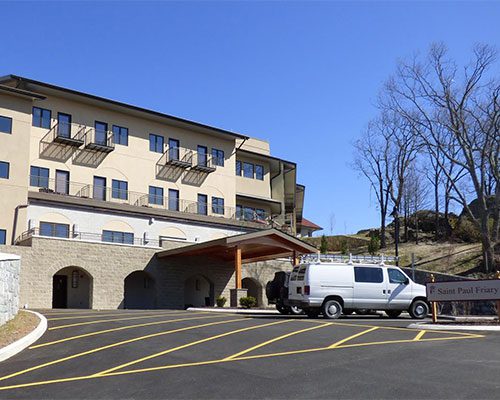
The St. Anthony Chapel of the New St. Paul’s Friary, completed in 2016, was dedicated on May 12, 2016. The Chapel is simple and Franciscan in style, using long glass panels to bring in the views of the Hudson Valley, and large glass panels near the ceiling to bring the sky and trees into view. The entry way is the location of the beautiful Little Flower panels of stained glass which tell the story of the Life of St. Therese of Lisieux. These panels were salvaged from the original Little Flower Chapel of the Friars.
VIEW AND DOWNLOAD A MAP OF GRAYMOOR
DIRECTIONS TO GRAYMOOR
Graymoor is located off US Route 9 in Garrison, NY, five miles north of Peekskill, NY, and 13 miles south of I-84. Use 40 Franciscan Way, Garrison, NY 10524 for GPS assisted driving directions.
By Train: Take Metro-North’s Hudson River Line from Grand Central (or 125th Street) to Peekskill. Taxi service is available from Peekskill to Graymoor for approximately $30.

